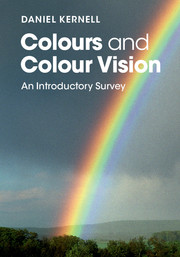Book contents
- Frontmatter
- Dedication
- Contents
- List of plates
- List of figures
- List of tables
- Preface
- 1 Colour vision in everyday life
- 2 The signals of colours: light and wavelengths
- 3 Colours and viewing conditions: not only local wavelengths
- 4 Our biological hardware: eye and brain
- 5 Eyes with unconventional properties: the ‘red-green blinds’
- 6 Other kinds of unconventional colour vision
- 7 Colour vision in different species of animals
- Appendices
- Notes
- References
- Index
- Plate section
3 - Colours and viewing conditions: not only local wavelengths
Published online by Cambridge University Press: 05 March 2016
- Frontmatter
- Dedication
- Contents
- List of plates
- List of figures
- List of tables
- Preface
- 1 Colour vision in everyday life
- 2 The signals of colours: light and wavelengths
- 3 Colours and viewing conditions: not only local wavelengths
- 4 Our biological hardware: eye and brain
- 5 Eyes with unconventional properties: the ‘red-green blinds’
- 6 Other kinds of unconventional colour vision
- 7 Colour vision in different species of animals
- Appendices
- Notes
- References
- Index
- Plate section
Summary
Colour interactions within a visual image
In the preceding chapter, results were described indicating that one might predict the perceived colour of a light if its wavelength composition is known. However, this is mainly valid for small and isolated portions of our central field of vision, e.g. for the observation of a small rotating colour top against a neutral background, or for Newton's prismatic spectrum displayed in a dark room. Our visual surroundings are typically much more complex; normally our eyes will simultaneously encounter a multitude of objects, differing in colour and lightness. Within such a complex scene, the colours perceived for each one of the various details will partly depend on local wavelength compositions, but partly it also depends on complex interactions between the various components of the scene. While we are looking, the brain uses a complex set of rules for correcting and adjusting all the colours before we perceive them.
Simultaneous contrast
In experiments concerning colour perception, colour samples are often used in the shape of small discs or pieces of paper which are shown against a neutral background. By such means, each colour may be judged on its own, in a state of relative isolation from other colours. It is important to realize that the same colour sample, having the same wavelength composition of its reflected light, might give quite a different colour perception in other surroundings or with another background (Plate 3.1). This concerns all the main dimensions of the colour: its hue, saturation and lightness. One of the common kinds of interaction concerns the ‘strengthening’ effects of adjacent opposites. A grey paper looks whiter against a black background. A yellow paper looks even more yellow against a blue background, and a blue colour becomes stronger against yellow. An interesting and paradoxical aspect of these interactions concerns the behaviour of complementary colours: they strengthen each other for adjacent surfaces, but they may instead sum and become very unsaturated if the two samples are small and close together (e.g. for minor stones in a mosaic, for threads in a woven tissue; cf. definition of complementary colours, Section 2.7).
One of the early scientists studying these colour interactions was the unusually long-lived French biochemist M.E. Chevreul (1786–1889). He is considered one of the founders of modern organic chemistry, and his work in this field led to a renewal of the soap and candle industry.
- Type
- Chapter
- Information
- Colours and Colour VisionAn Introductory Survey, pp. 74 - 98Publisher: Cambridge University PressPrint publication year: 2016



